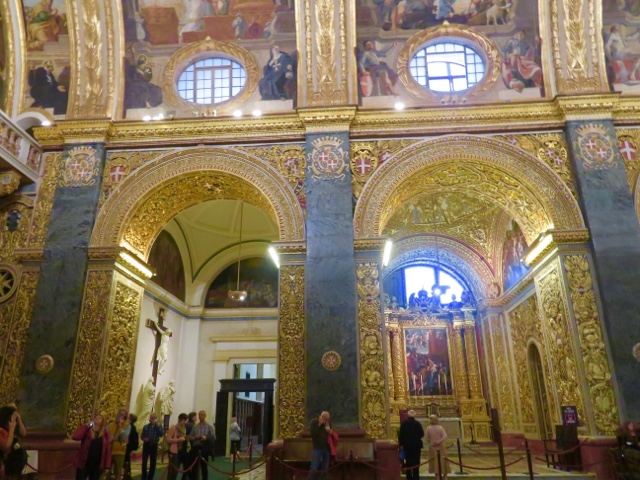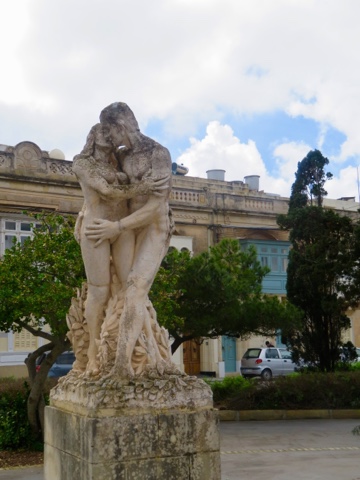Malta is an archipelago of 21 islands in the central Mediterranean between Sicily and the North African coast. The country covers just over 316 km2 with a population of just under 450,000 making it one of the world's smallest and most densely populated countries.
Our first day there was a Sunday and it seemed lots of people were out for a stroll on the long promenade which runs from Sliema to the next town,St Julian's.
Reading in the sun...
Enjoying the sunny day by the water...
Playing on the art installations...
And swimming...
Don was disappointed by the sign though...
The scenery as we walked was amazing...
The typical Maltese fishing boats are brightly coloured...
Sliema is directly across the harbour from the capital of Malta which is an old city called Valletta, which is also a very small capital city. To get there we took the ferry across...
The domed roof of the Cathedral is a centrepiece of the skyline...
As we were crossing the harbour we noticed this yacht parked nearby, it was huge...
In fact during the week we spent in Malta we constantly saw expensive cars, expensively dressed people and very expensive food. In talking to people here they told us that the economy was booming and everyone who wanted to work did, so little unemployment.
After getting off the ferry we walked around the city, up and down hills...
The city was built in the 1500s by The Knights of the Order of St. John who saw its position to be favourable to withstand attacks since it was on the end of a peninsula with a guarded harbour. One of the first buildings was the fort and the massive walls...
The entrance to the harbour...
Over the centuries Malta has been under attack and seized by many including the Romans, the Turks, the French and finally the English. The last siege was during World War 11 when it was heavily bombed by the Italians, this peace tower is dedicated to all who died, along with the recumbent wounded soldier monument...
There are lots of places to sit and watch the world go by...
One particular feature of Valletta is the Maltese balcony which appeared in the last quarter of the 17th century as a result of the increasing influence of the baroque movement, of which the balcony was a favourite device, in Europe. There are lots of styles and colours...
And finally a little about Saint John's Cathedral which is dedicated to Saint John The Baptist. It was built by the Order of St. John between 1572 and 1577. The church was designed by the Maltese architect,Girolama Cassar who designed several of the more prominent buildings in Valletta. In the 17th century, its interior was redecorated in the Baroque style by Matti Preti and other artists. The church is considered to be one of the finest examples of high Baroque architecture in Europe and one of the world's great cathedrals.
We have been in a lot of churches but this one is one of the most breathtaking in that the decoration of almost every surface is unbelievable.
Here are some images which really don't do justice to the church...
The church has a giant dome which has panels decorated with scenes from Saint John's life which Preti painted with oil on concrete.
The floor consists of hand painted panels indicating the person buried below each one...
Each side chapels, there are eight representing the founding countries of the Order of Saint John are also richly decorated...
Their symbol, the Maltese cross is everywhere...
A beautiful sculpture made of marble of my favourite image, mother and child...
The altar...
Another positive experience was using the public bus system which took us around the island and beyond for about 2 dollars a trip. One day we took a bus for about an hour to one of the most ancient cities of Malta called Mdina or Rabat, the old Muslim name. It was founded in the 8th century BC by Phonecian settlers and is a fortified city. It is very well maintained and a top tourist site in Malta.
We visited on a sunny day and here are some of our impressions...
Noticed this one right away...
On to the gate of the city...
Narrow streets
This is city where people still love and work and they have great doors...
Religiously symbols on all their houses...
Beautiful squares...
Small, brightly painted churches...
And great views of the surrounding countryside
In the adjoining town of Rabat, outside the walls we found St. Paul's grotto where the story goes Paul spent three months when he was shipwrecked on Malta...
The grotto is under the church and was also used as shelters when Malta was bombed during the war...
On the way there we passed a Maltese cemetery which was very interesting...
And finally a last view of the countryside from Rabat before heading home on the bus, again a beautiful part of the country...
As I mentioned earlier we found the cost of eating out in Malta very expensive so we often ate our breakfast and supper in and tried some of the local food for lunch. Here I am trying the pastizz, a pastry made of phyllo and stuffed with either ricotta cheese or mushy peas.
Rabbit is also a big menu item, but Don couldn't bring himself to spend that much on a piece of rabbit when he has them bottled at home!
Our final day trip was to one of the other islands to the north of Malta called Gozo, again we took the bus to the ferry and about 25 minutes there across the channel...
Gozo island is much smaller than Malta and has a very rural feeling to it. We took a hop on Hop off bus around the island and again the views were fabulous ...
The little harbour where the ferry docked.
The island has a rocky coastline...
It also has a number of very old lookout towers that were built to protect the island...
Lots of small fishing villages...
And little beaches...
Gozo also has lots of small farms that produce much of what is eaten here...
Since it is winter here the countryside is very green...
As we drove around we could see little hilltop villages always with a church as the Center...
Churches on every horizon...
In 1814, as part of the Treaty of Paris, Malta officially became a part of the British Empire and was used as a shipping way-station and fleet headquarters.Malta achieved its independence on 21 September 1964 so there are still a lot of British influences on the island with islanders speaking both Maltese and English.
The capital of Gozo then is called Victoria after the Queen of England. We stopped there for awhile to check out the town...
The most visited site is The Cittadella is built on a promontory overlooking the present day city of Victoria. This location was originally chosen because it is a naturally defensible hill, dominating the surrounding countryside and having views of large parts of the coastline.
The largest attack on the Cittadella took place in July 1551, when a large Ottoman force besieged the Cittadella. The Governor offered terms of surrender, but they were refused and the castle fell within a matter of days. It was sacked and most of the 6,000 Gozitans who took refuge there were taken as slaves.
There has been a lot of EU money gone into this restoration project and it is well preserved...
The church inside the Citadel...
Malta is really a place of great history and natural beauty with a mild winter climate making it ideal for the many winter visitors we met, mostly from the UK. We really enjoyed our time here, the weather was great, the place very peaceful and easy to navigate. If you are thinking about visiting Malta we strongly recommend it.













































































I'm pretty sure I could live in Malta. It is so colourful and the church is amazing. baroque is always over the top and ornate but that church is tasteful and elegant. Love it!
ReplyDeleteAnne, I too think it would be an easy place to live especially for the winter. Not as hot as Mexico but still offering a nice lifestyle.
Delete